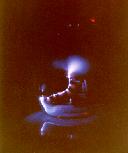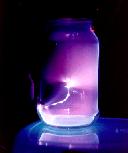


Bottom electrode at 20kV from flyback (20kHz), lid floating. Pressure decreases from left to right: normal pressure left, minimum pressure right. (to be honest, the left photo is only a darkened version of the middle one; the photo I originally took came out just black.)
Bottom electrode and lid connected to 10kV (max.) oil burner transformer (50Hz), pressure minimum. From left to right, voltage is increased from about 3/4 to maximum. Under normal pressure, 10kV is barely enough to arc over a few millimeters; the distance here is about 7cm.
A plasma globe is an airtight conatiner (preferably transparent:-), filled with air or, better, nobel gases at low pressure. It has an electrode inside, to which high voltage, high frequency electricity is supplied, which then causes the gas to emit a characteristic light.
 What I tried is only a very primitive first step, but works at least
:-) I basically use a marmelade jar. I drilled a hole in the lid,
soldered copper tubing on it for the vacuum pump and put an
additional rubber O-ring between the lid and glass (this was cut from
an old inner tire). The lid can be used as the electrode (attach a
needle etc. to it, on the inside), but to have a second electrode, I
drilled another hole through the glass and inserted a screw and piece of
wire. Drilling through glass takes a good stone drill and lots of
time. Keep the drill and hole in water, and don't push too hard.
What I tried is only a very primitive first step, but works at least
:-) I basically use a marmelade jar. I drilled a hole in the lid,
soldered copper tubing on it for the vacuum pump and put an
additional rubber O-ring between the lid and glass (this was cut from
an old inner tire). The lid can be used as the electrode (attach a
needle etc. to it, on the inside), but to have a second electrode, I
drilled another hole through the glass and inserted a screw and piece of
wire. Drilling through glass takes a good stone drill and lots of
time. Keep the drill and hole in water, and don't push too hard.

The vacuum pump I used is a simple hand pump (don't know where it came from). Works like a bicycle pump, but the sealing between piston and cylinder is "inverted". The minimum pressure reachable is about 1/12th normal pressure, or 80mBar, or 60 Torr. Real plasma globes usually have pressures well below that.
However, using Helium or other nobel gases, you can even make a kind of plasma globe even at normal pressure, and air works works good at 80mBar, as you can see above!